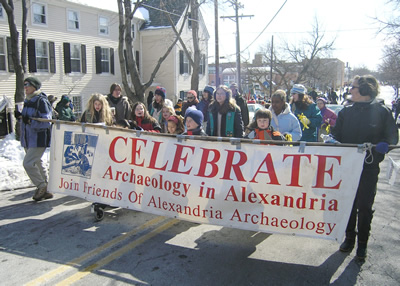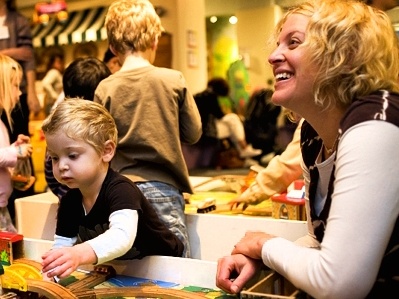
During the 1960s, Washington, DC and its surrounding communities experienced an urban renewal that saw a rebuilding of infrastructure and consequently required the destruction of a number of older buildings in the area. In Alexandria, an independent city a short distance from DC, the destruction of the old buildings uncovered an abundance of historical artifacts that shed light on the history of the area. Realizing that there was a plethora of previously undiscovered, culturally-important artifacts right beneath their feet, the city’s leadership created the Office of Historic Alexandria to try to cultivate and make sense of this new information.
Read more »
Terms:Community Building, Community Engagement, Creative Economy, Cultural Institutions, Heritage, Historic Preservation, IFC Best Practice, Museums, Public-Private Partnerships, Tourism, Washington, DC

The Habitot Children’s Museum first opened its doors in downtown Berkley in 1998, and the institution has served over 950,000 residents of underserved communities in the Bay Area since. The 7,000 sq. foot facility is home to exhibits that help teach kids about the value of physical activity, water preservation, and art and culture. The hands-on Museum encourages early childhood education and aims to help support a generation of curious and creative kids.
Read more »
Terms:Arts & Culture, Community Building, Creative Economy, Cultural Institutions, Downtown Development, Education, Families, IFC Best Practice, Institutions as Fulcrums of Change , Museums, Youth
 photo credit Phoenix New Times photo credit Phoenix New Times
The Arizona Science Center has long engaged adult volunteers age 50+ as docents, and in
other conventional volunteer roles, but only recently the Center began to tap volunteers’ science and technology skills to enhance its programs. Jan Stonebraker, the Science Center volunteer coordinator of four years, entered the position as the Center launched a large travelling exhibition titled Body Worlds 3, an exploration of biology and anatomy.
Stonebraker identified knowledgeable volunteers to help staff the exhibition. At around the same time, the Virginia G. Piper Charitable Trust funded a leadership grant program, through the National Council on Aging (NCOA), to engage adult volunteers age 50+ in leadership roles. The Science Center development staff and Stonebraker designed a program that would qualify for a grant. Stonebraker found that many volunteers were retired mechanical and electrical engineers, information technology specialists, and science teachers who wanted to help the Center. It made eminent sense to use their skills to enhance educational programs.
Read more »
Terms:2012, Aging, Aging in Place, AIP Best Practice, Arizona, City Leaders Institute on Aging in Place, Community Engagement, Education, Intergenerational, Jobs, Life-Long Learning, Museums, Public-Private Partnerships
 photo credit Osher Lifelong Learning Institutes photo credit Osher Lifelong Learning Institutes
Now a network of 117 higher education institutions spread across the country, Osher Lifelong Learning Institutes (OLLI) offer college-level courses designed to appeal to the interests and experience of older adults. OLLI programs are adapted to the needs and desires of the communities they serve, but they benefit from OLLI’s National Resource Center, which provides a network for sharing innovations in lifelong learning and also sponsors an annual conference. The institutions comprising OLLI range from top research universities to community colleges, and all provide unique programs.
Duke University’s is one of the most successful Osher Lifelong Learning Institutes in the country. The program began as the Duke Institute for Learning in Retirement, which was founded in 1977 as a joint venture between Duke Continuing Education and the Center for the Study of Aging and Human Development. Duke became one of the Osher Lifelong Learning Institutes in 2004.
Read more »
Terms:2012, Aging, Aging in Place, AIP Best Practice, Arts & Culture, City Leaders Institute on Aging in Place, Community Engagement, Education, Museums, National, Regional Cooperation, Town-Gown, Transportation
Entrepreneurial American Leadership Award
For her extensive career in the preservation and promotion of local arts, culture, and heritage for our diverse American population.
Read more »
Partners’ recent forum with the Hirshhorn Museum, “ Building Livable Communities: Creating a Common Agenda,” served as a positive platform to re-announce a new and exciting agenda for architecture, design, and social experimentation: The Hirshhorn Museum and Sculpture Garden’s Bubble Expansion and book store renovation. Attended by Congressional representatives, federal agencies, think tanks, cultural institutions, and community development leaders alike, Director of the Hirshhorn Museum Richard Koshalek discussed the museum’s upcoming plans. The "Bubble,” as it is called for the short-term, is a joint venture of Koshalek and Diller, Scofidio + Renfro, a renowned New York-based design firm, to re-invent the Museum as an intentional classroom and illustrate intersections of public and private space. Additionally, the museum book store will undergo a transition from a common commercial entity to becoming integrated as a part of museum exhibition space, through a renovation and move to the basement of the building. Perhaps this new agenda comes from the idea that we need to adapt spaces to peoples’ readily changing needs. Perhaps this comes from Richard Koshalek’s desire to make the Hirshhorn a world class modern art museum with a daring new exposition. Perhaps this comes from the need to blur public and private space by incorporating The "Bubble” as an almost space-less entity into a negative, or void, of the concrete mass building; and the book store as an experiment in museum exhibit space. Or perhaps this agenda just comes from a need to make the stolid flimsy, the serious fun, and the patron part of the exhibit.
Long considered by many as the center of high society and fine art, museums have established themselves as the elite foundation for what many museum directors proudly describe as the, “cathedrals of culture.” In vibrant metropolises, urban museums have sought to find a composite group of high class patrons amongst the density and heterogeneous nature of the city. Up until recently, museum collections sought out only the most exclusive and rarest of art as a top priority in the agenda held by longtime directors. In the current era, however; a major trend has occurred amongst many of the directors who are facilitating new programs that allow each institution to provide a focused area for creating a multicultural setting in the local community.
Read more »
Planning and public service provision have not always been open to constituent input at all stages of the development process. The past few decades, however, have brought increased public desire to provide input, and technology has further helped to facilitate this participation in more efficient and effective ways.
Read more »
Arts and Cultural Institutions: Developing New Audiences and Better Neighborhoods. In the next two decades, this country will see a major shift in demographics of the population.The number of adults age 65+ in the U.S. will double, to more than 70 million. This upward trend is also true of the immigrant population. Immigrants now account for one in eight U.S. residents, the highest level in 80 years. For organizations that provide opportunities for arts and cultural participation, these demographic trends represent a challenge and an opportunity to expand their audiences and take leadership roles in their communities. How are arts and cultural institutions responding? What types of programs have been instituted? What new partnerships have been made? How has staff composition changed? These are questions that Partners has been asked to answer thanks to funding from MetLife Foundation. We are approaching arts and cultural organizations in six major cities—Atlanta, New York City, Phoenix, Dallas, Tampa and Chicago—about how and why they are reaching out to these two growth populations. If you have a program reaching out to older adults or immigrants, we would like to hear from you. You do not need to be located in one of the cities above—all good programs are welcome. Please contact Penny Cuff at Partners (
This e-mail address is being protected from spambots. You need JavaScript enabled to view it
or 202-887-5990 x 101).
Read more »
San José, CA
An arts organization teams up with a small, local business to create a central gathering place and cultural center within a struggling neighborhood.
Read more »
Terms:Arts & Culture, CBC Best Practice, Community Building, Community Development, Community Engagement, Cultural Institutions, Culture Builds Communities, Diversity, Multicultural, Museums, Neighborhood Revitalization, Placemaking, Public Art, San José, CA , Social Capital, Urban
North Adams, MA
A cultural institution has brought stupendous growth to the surrounding community.
Read more »
Terms:Arts & Culture, CBC Best Practice, Community Development, Cultural Institutions, Culture Builds Communities, Design, Downtown Development, Economic Development, Historic Preservation, Museums, Neighborhood Revitalization, North Adams, MA, Tourism, Town-Gown
Memphis, TN
A museum which educates the public on the Civil Rights Movement and preserves the historic location of Dr. Martin Luther King’s assassination.
Read more »
Terms:Arts & Culture, Community Development, Community Engagement, Cultural Institutions, Diversity, Education, Heritage, Historic Preservation, Memphis, TN, Museums, Placemaking, Public-Private Partnerships, Tourism
Queens, NY
A program that uses the rich cultural heritage of the community to engage and educate neighborhood youth
Read more »
Terms:Arts & Culture, CBC Best Practice, Community Building, Community Development, Community Engagement, Cultural Institutions, Culture Builds Communities, Heritage, Immigration, Multicultural, Museums, Neighborhood Revitalization, New York City, NY, Parks, Playgrounds & Gardens, Placemaking, Public Art, Social Capital, Urban, Youth
Entrepreneurial American Community Award
For its 25 years of collaboration with Partners for Livable San Diego on quality of life improvements and community building practices.
Read more »
Terms:2007, Awards, Community Building, Community Development, Cultural Institutions, Downtown Development, Entrepreneurial American Community Award, Museums, Placemaking, Public-Private Partnerships, San Diego, CA
Founders Award for Civic Leadership
Senior Advisor at the National Underground Railroad Freedom Center, for furthering cultural heritage development and historic preservation for over 40 years.
Read more »
Terms:2007, Arts & Culture, Awards, Cincinnati, OH, Cultural Institutions, Founders Award for Civic Leadership, Heritage, Historic Preservation, Museums, Neighborhood Revitalization, Placemaking

Written by Tom Borrup with Partners for Livable Communities, this book features best practices and technical assistance how-to's on using culture as a fundamental tool for transformative community development. The book is a tool of broad scope covering topics such as: Asset Mapping; Funding and Policy; Effective Partnerships; Assessment and Evaluation. The book follows up on Partners ground-breaking Culture Builds Communities work.
Borrup writes, “In 1993 PLC began an extensive developmental program called Culture Builds Community, which aims to systematically place cultural assets within the portfolio of community development efforts…Nationwide in scope, the program gave rise to a publication, Culture Builds Communities, that inspired this book.”
Published by Fieldstone Alliance, Saint Paul, MN, 2006, 261 pages ($25)
(This Report/Book is only available for purchase. Partners does not have an electronic version available)
Read more »
Terms:2006, Arts & Culture, Books/Reports For Sale, CBC Report/Publication, Community Building, Community Development, Community Engagement, Cultural Institutions, Culture Builds Communities, Economic Development, Multicultural, Museums, Neighborhood Revitalization, Partners Reports/Publications, Social Capital
|
|